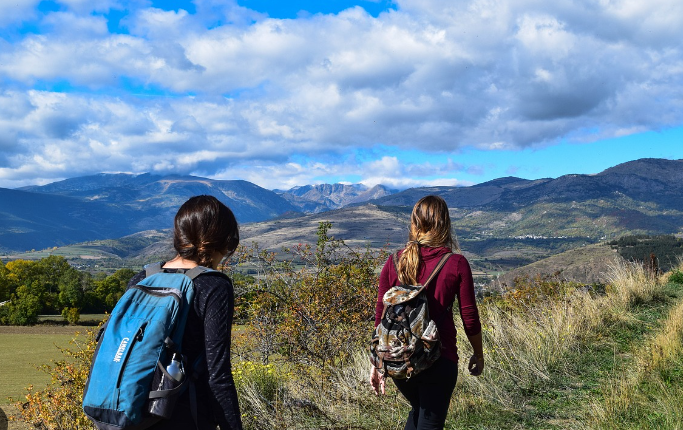
Hiking trails offer a unique opportunity to explore the great outdoors, connect with nature, and challenge ourselves physically. Whether you are an experienced hiker or just starting out, there are numerous hiking trails available that cater to all skill levels and interests. In this article, we will delve into the world of hiking trails, discussing their benefits, popular destinations, safety tips, and equipment essentials.
Benefits of Hiking Trails
Hiking trails provide a multitude of benefits for both the body and mind. Here are some key advantages:
1. **Physical Fitness**: Hiking is a fantastic form of exercise that engages various muscle groups, improves cardiovascular health, and enhances overall fitness levels. When hiking, your body is constantly in motion, navigating uneven terrain and overcoming obstacles. This helps build strength in your legs, core, and upper body. Additionally, hiking is a weight-bearing exercise, which promotes better bone density and reduces the risk of osteoporosis. It is a low-impact activity that puts less stress on your joints compared to running or other high-intensity exercises.
2. **Mental Well-being**: Spending time in nature and disconnecting from the daily hustle and bustle can reduce stress, boost mood, and improve mental well-being. Hiking allows you to escape the noise and distractions of everyday life, providing a peaceful environment to clear your mind and relax. The fresh air, sunlight, and natural surroundings have a calming effect on the brain, helping to reduce anxiety and improve overall mental health. Research has shown that spending time in nature can also enhance creativity and cognitive function, making hiking a great way to boost your productivity and problem-solving skills.
3. **Sights and Sounds**: Hiking trails often take you through breathtaking landscapes, allowing you to enjoy scenic views, observe wildlife, and appreciate the beauty of the natural world. Whether you’re hiking through lush forests, majestic mountains, or serene coastal paths, the sights and sounds of nature can be awe-inspiring. You might encounter beautiful wildflowers, cascading waterfalls, or even spot some elusive wildlife along the way. Taking the time to appreciate these natural wonders can bring a sense of joy, wonder, and gratitude, enhancing your overall hiking experience.
4. **Connection with Nature**: Hiking allows you to immerse yourself in nature, promoting a sense of tranquility and connectedness with the environment. It gives you a chance to unplug from technology and reconnect with the natural world. The rhythmic sounds of birds chirping, leaves rustling, and rivers flowing can have a soothing effect on the mind and create a feeling of harmony. Being surrounded by nature’s beauty can also foster a sense of gratitude and environmental awareness, inspiring you to become a better steward of the earth.
5. **Exploration and Adventure**: Hiking trails offer the opportunity to explore new territories, discover hidden gems, and embark on exciting adventures. Whether you’re exploring a local trail near your home or venturing to a far-off destination, hiking allows you to satisfy your curiosity and sense of adventure. You can uncover hidden waterfalls, stumble upon ancient ruins, or witness breathtaking vistas that few have laid eyes on. Each trail has its own unique characteristics and challenges, making every hike a new and thrilling experience.
In summary, hiking trails provide a wide range of benefits, including improved physical fitness, enhanced mental well-being, the opportunity to appreciate nature’s beauty, a sense of tranquility and connectedness, and the thrill of exploration and adventure. Whether you’re seeking a challenging trek or a leisurely stroll, there is a hiking trail out there for everyone to enjoy.
Popular Hiking Trail Destination
When it comes to hiking trails, there are countless destinations to choose from. Here are a few notable options:
1. Appalachian Trail, United States
Spanning over 2,180 miles, the Appalachian Trail is a legendary hiking route stretching from Georgia to Maine. It traverses diverse landscapes, including mountains, forests, and meadows, offering hikers a truly immersive experience in the eastern United States. As you hike along this iconic trail, you’ll encounter stunning views of the Great Smoky Mountains, the Shenandoah Valley, and the White Mountains of New Hampshire. The Appalachian Trail provides hikers with an opportunity to challenge themselves physically and mentally while experiencing the beauty and serenity of the American wilderness.
2. Inca Trail, Per
For those seeking a unique cultural experience along with their outdoor adventure, the Inca Trail in Peru is an excellent choice. This ancient trail leads to the magnificent ruins of Machu Picchu, allowing hikers to explore Inca history while enjoying breathtaking views of the Andes Mountains. The Inca Trail is a 26-mile trek that takes you through diverse ecosystems, including cloud forests, alpine tundra, and high mountain passes. Along the way, you’ll pass through various Inca archaeological sites, such as Wiñay Wayna and Inti Punku (the Sun Gate), before finally reaching the awe-inspiring Machu Picchu. This trek is not only physically demanding but also culturally enriching, as it offers a glimpse into the fascinating world of the Inca civilization.
3. Everest Base Camp Trek, Nepal
The Everest Base Camp Trek is a bucket-list-worthy adventure for experienced hikers. This challenging trail takes you through the stunning Himalayas, showcasing majestic peaks and allowing you to witness the world’s highest mountain, Mount Everest, up close. The trek starts in Lukla, a small town in Nepal, and follows a route that passes through remote Sherpa villages, ancient monasteries, and breathtaking valleys. Along the way, you’ll be treated to panoramic views of towering peaks like Ama Dablam, Lhotse, and Nuptse. Reaching Everest Base Camp is an incredible achievement, offering a sense of accomplishment and the opportunity to witness the awe-inspiring beauty of the Himalayas.
These are just a few examples of popular hiking trail destinations, each offering its own unique experiences and challenges. Whether you’re a beginner or an experienced hiker, there are hiking trails all over the world waiting to be explored.
Safety Tips for Hiking Trails
While hiking trails provide incredible experiences, it is crucial to prioritize safety. Here are some essential safety tips to keep in mind:
– **Plan and prepare**: Before embarking on a hike, it’s important to research the trail thoroughly. Familiarize yourself with the route, difficulty level, and any potential hazards. Check the weather forecast and dress accordingly. Make sure you have the necessary skills and equipment for the hike.
– **Tell someone your plans**: Always inform a friend or family member about your hiking plans. Share details such as the trail name, estimated duration, and expected return time. This way, someone will know to raise the alarm if you don’t return as planned.
– **Stay on the trail**: It’s important to follow designated paths and avoid venturing off on unmarked routes. Straying from the trail increases the risk of getting lost or encountering wildlife unexpectedly. Stick to marked paths and respect any closures or restrictions for your safety.
– **Pack essentials**: Be prepared by carrying essential items such as a map, compass, first aid kit, sufficient water, food, extra clothing, and emergency supplies. It’s also a good idea to have a whistle and a flashlight in case of emergencies. These items can be lifesavers if you encounter unexpected situations or get stuck on the trail for longer than anticipated.
– **Dress appropriately**: Dress in layers and wear comfortable, moisture-wicking clothing suitable for the weather conditions. Choose sturdy hiking boots that provide good ankle support and traction. Don’t forget to apply sunscreen to protect your skin from the sun’s harmful UV rays. It’s also important to wear a hat and consider using sunglasses with UV protection to shield your eyes.
– **Hike in a group**: Whenever possible, hike with others. Hiking in a group enhances safety as you can look out for each other, share resources, and provide assistance if needed. It also adds to the enjoyment of the experience, allowing you to share the beauty of nature with like-minded individuals.
– **Stay hydrated and nourished**: Drink plenty of water throughout your hike to stay hydrated, especially on hot and strenuous trails. Carry lightweight, high-energy snacks to keep you fueled and maintain your energy levels. It’s important to listen to your body and take breaks when needed.
– **Respect wildlife and the environment**: As you explore hiking trails, it’s essential to leave no trace and minimize your impact on the environment. Follow any rules or regulations specific to the trail, such as not feeding wildlife or picking flowers. Be mindful of your surroundings and avoid disturbing animals or damaging natural habitats. By respecting nature, you contribute to the preservation of these beautiful landscapes for future generations to enjoy.
By following these safety tips, you can ensure a safe and enjoyable hiking experience, allowing you to fully immerse yourself in the wonders of nature.
## Equipment Essentials for Hiking Trails
Having the right equipment is vital for a safe and enjoyable hiking experience. Here are some essential items to include in your hiking gear:
– **Backpack**: Choose a comfortable backpack with proper support and ample storage space. Look for one that fits well and allows you to distribute the weight evenly on your shoulders and hips.
– **Hiking Shoes**: Invest in sturdy, waterproof hiking shoes that offer good traction and ankle support. Proper footwear is crucial for preventing blisters, ankle sprains, and discomfort on the trail. Make sure to break in your shoes before embarking on a long hike.
– **Clothing**: Dress in layers to accommodate changing weather conditions and regulate your body temperature. Opt for moisture-wicking, breathable fabrics that dry quickly and keep you comfortable. Consider wearing a base layer, mid-layer, and outer layer, depending on the climate. Don’t forget to bring a hat to protect your head from the sun and rain, sunglasses to shield your eyes, and rain gear in case of wet weather.
– **Navigation Tools**: Carry a map, compass, or a GPS device to navigate the trail effectively. Familiarize yourself with the route beforehand and have a backup navigation method in case electronic devices fail. It’s important to know how to read a map and use a compass to avoid getting lost.
– **First Aid Kit**: Pack a well-stocked, lightweight first aid kit with essentials like bandages, antiseptic wipes, and pain relievers. Include any necessary medications specific to your needs. It’s important to know how to use the items in your first aid kit, so consider taking a basic first aid course before your hike.
– **Water and Snacks**: Carry enough water to stay hydrated throughout your hike. The amount will depend on factors such as the duration of the hike, weather conditions, and your personal hydration needs. Pack lightweight, high-energy snacks that provide a good balance of carbohydrates, protein, and fats to keep you fueled and maintain your energy levels.
– **Safety Gear**: Include a whistle, flashlight, multi-tool, and a small emergency shelter like a lightweight tarp or space blanket. These items can be essential in emergency situations. The whistle can be used to alert others if you’re lost or in danger. A flashlight is crucial if you find yourself hiking in low-light conditions or need to signal for help. A multi-tool can come in handy for various tasks, such as repairing gear or opening cans. An emergency shelter provides protection from the elements if you’re stranded or need to wait for help.
– **Sun Protection**: Protect yourself from the sun’s harmful UV rays by applying sunscreen with a high SPF before starting your hike. Reapply as needed throughout the day. Wear a hat to shade your face and neck, and consider using sunglasses with UV protection to shield your eyes from the sun’s glare.
– **Personal Items**: Bring personal necessities such as any medications you require, insect repellent to ward off bugs, and hand sanitizer to keep your hands clean. It’s also a good idea to carry a small amount of cash, identification, and a cell phone for emergencies. Make sure your cell phone is fully charged before setting off on your hike.
Remember, the specific gear you need will depend on the trail difficulty, weather conditions, and the duration of your hike. It’s essential to research your chosen trail thoroughly and pack accordingly. Consider consulting with experienced hikers or outdoor retailers for specific gear recommendations based on your hiking plans.
As you set out on your hiking trail adventures, ensure you are well-prepared, taking into account safety measures, equipment needs, and the destination’s unique characteristics. By immersing yourself in nature and exploring these incredible trails, you can truly experience the wonders of the great outdoors while reaping the physical and mental benefits that hiking has to offer.






